Siamese fighting fish keepers around the globe share one thing in common – the love for their beautiful, unique, and often aggressive pets. Crowntail bettas are a species of betta fish that is prized for its unique tail shape and vibrant colors. The lack of webbing on the fins and the extended filaments on the tail make crowntails one of the most sought-after varieties of betta fish.
As with any pet, owning a crowntail betta comes with certain responsibilities. In this article, we will discuss everything you need to know about these beautiful fish, from their lifespan and care requirements to the best way to set up their tank.
Characteristics/Appearance/LifeSpan
Common Name (species)
Crowntail Betta Fish, Siamese Fighting Fish (Generic)
Family
Osphronemidae
Origin
Southeast Asia
Diet
Carnivore
Care Level
Easy
Activity
Active, social, alert
Temperament
Aggressive
Tank Level
Top
Minimum Tank Size
5 Gallons
Temperature Range
72 – 80 degrees Fahrenheit
Water Hardness
5 – 20 dH
pH Range
6.5 – 7.5
Filtration/Flow Rate
Calm
Breeding
Egg layer
Compatibility
Similarly-sized community fish
OK, for Planted Tanks?
Yes, but make sure the plants do not have jagged edges.
What Do Crowntail Betta Fish Look Like?
Crowntail bettas are small, brightly-colored fish that are easily recognizable by their long, flowing fins and tails. The tail itself is divided into many small, sharp rays that give it a “crown” appearance. Spiky fins and a long, flowing tail make crowntails one of the most popular betta fish varieties.
The vibrant colors of crowntail bettas are another reason for their popularity. These fish come in various colors, from deep reds and purples to bright blues and greens. Some crowntails even have multi-colored patterns on their fins and tails! As long as these colorful fishes has the characteristic crowntail shape, they can be any color.
Crowntail bettas typically grow to be 2-3 inches in size. Adult fish also have splayed-out fins measuring up to 4 inches in diameter. What does this mean for you, the potential owner? Well, it means that crowntails need a bit more space than other betta fish varieties. We’ll discuss this in more detail later on.
How Long Do Crowntail Betta Fish Live?
The lifespan of a crowntail betta fish is typically 3-5 years. As far as pet fish go, this is a fairly long lifespan. Unfortunately, many bettas do not live nearly this long due to poor care and living conditions. There is a lot of misinformation out there about how to care for these fish, so it’s important to do your research before bringing one home.
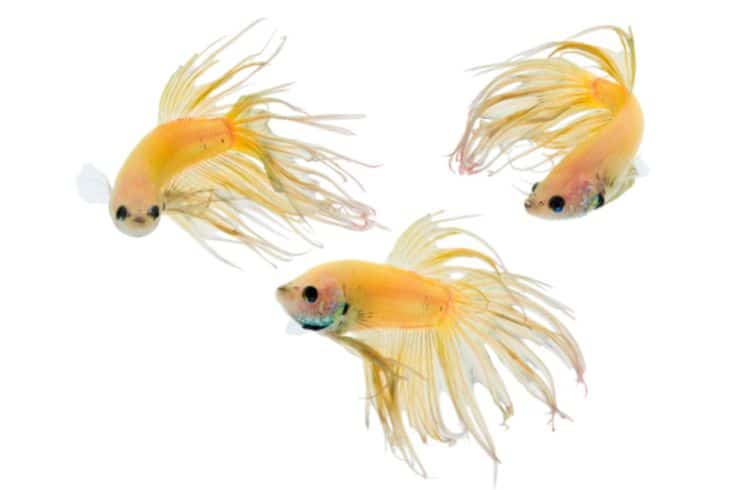
A key factor in determining a betta’s lifespan is the quality of water they live in. Many assume that because these fish are labyrinth breathers, they can live in poor water conditions. This is simply not true. While bettas can rely on their labyrinth organ to supplement their oxygen intake, they still need clean, well-oxygenated water to thrive. The opercula membrane, which helps the fish pump water over their gills, can become damaged in poor water conditions.
Like most fish species, crowntail bettas will live longer and be healthier if kept in a well-maintained aquarium. So, if you want tons of quality time with your pet fish, ensure they provide the best possible care.
Temperament and Tankmates
Bettas are known to be aggressive fishes that will show dominant behavior around their tank mates. However, this isn’t an accurate or fair representation of all bettas. Crowntail bettas are intelligent fish that need to be housed with compatible tank mates in order to thrive. This is the case with all fish in captivity – aggressive behavior is often a result of poor living conditions and incompatible tank mates.
The best tank mates for crowntail bettas are small, peaceful fish that are not overly active. Good choices include danios, Corydoras catfish, and Kuhli loaches. These fish are all relatively inactive and can hold their own against a betta’s aggression. It’s important to avoid housing your betta with other aggressive fish, as this will only lead to your fish fighting and stressing each other out.
If you own a female crowntail, another option is to keep her in a species-only tank. This means the only fish in the tank will be other female betta fish. While females can be kept with other fish species, they often do better when they are the only bettas in the tank. This is because male and female bettas can be quite aggressive towards each other, especially when the female is in spawning condition.
What Do Crowntail Bettas Eat?
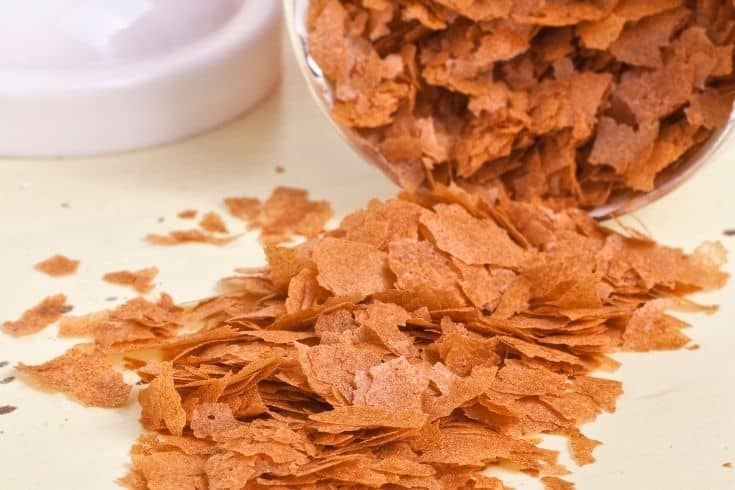
Crowntail bettas are carnivores that primarily eat live foods. They are sometimes described as insectivores that feed on wingless fruit flies, mosquito larvae, and most other insect larvae. These foods contain plenty of protein, and help bettas to maintain their vibrant colors.
Although most bettas with a healthy appetite would be happy feasting on live foods all day, this may not be feasible in your home. Feeding dry pellets two times a day is a good way to supplement your betta’s diet. Many high-quality betta pellets on the market contain all the nutrients your fish needs in a balanced diet. Be sure to look into specific brands of food made for bettas, as regular fish food will not contain all the necessary nutrients.
You can also offer your betta live treats from time to time. There are lots of frozen food options that are perfect for bettas, and can be found at most pet stores. These include blood worms, brine shrimp, and daphnia. Proper food is essential for a crowntail betta’s health and longevity, so be sure to source high-quality options.
While high-protein food should make up the majority of a crowntail’s diet, most enthusiasts agree that feeding them a small quantity of vegetation can be beneficial. Something between 5-10% of their overall diet should be plant-based. This can include blanched vegetables like zucchini, cucumber, and spinach.
Feeding Frequency: How Do You Prevent Overfeeding?
Crowntail bettas should be fed 2-3 times a day, with each meal consisting of 3-5 pellets. This is just a general guideline – some fish may be able to eat more, while others will do better with less food. It’s important to keep an eye on your betta’s appetite, and to only offer them as much food as they can eat in 3 minutes.
Bettas have small stomachs, and overfeeding can lead to health problems. One of the most common issues associated with overfeeding is swim bladder disease. This is a condition that prevents a fish from swimming properly, and is often the result of a bloated stomach. If you notice your betta having trouble swimming, immediately reduce the amount of food you are offering.
Another way to prevent overfeeding is to fast your betta one day per week. This gives their digestive system a chance to rest, and can help to prevent swimbladder disease. On fasting days, you can offer your betta a small piece of vegetable as a treat.
Habitat Requirements – What Size Tank Do Crowntail Bettas Need?
Crowntail bettas are relatively small fish, but this doesn’t mean that they should be housed in fish bowls or other small tanks. Aquarium water can quickly become stagnant and polluted, which can lead to health problems in your fish. A good rule of thumb is to choose a tank that is at least 5 gallons in size for a single betta, though we recommend a 10-gallon tank that will accommodate plants and other forms of tank décor.
A 20-30 gallon tank is ideal if you intend to house multiple crowntail bettas. It’s important to remember that these fish are quite territorial, so it’s best to give them plenty of space to spread out. Because they breathe air from the water’s surface, choosing a tank with plenty of surface area is also important.
In addition to these physical requirements, here are some other things to keep in mind when choosing a tank for your crowntail betta:
Water Temperature
Crowntail bettas are tropical freshwater fish, and prefer water that is between 76-82 degrees Fahrenheit. It’s important to maintain a consistent water temperature, as large fluctuations can lead to stress and temperature shock. This is a condition that can be fatal to fish, so it’s best to avoid it altogether.
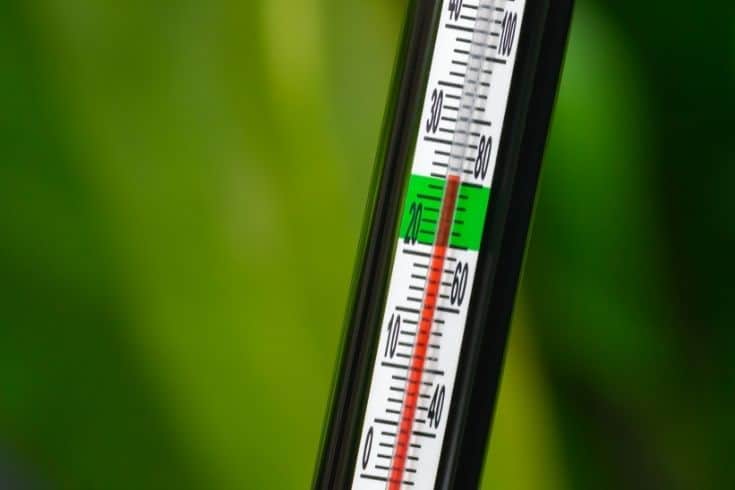
To make sure your water is the right temperature, we recommend investing in an aquarium heater. These devices are relatively inexpensive, and will help to keep your water at a constant temperature. You can also use a tank thermometer to monitor the water temperature, and make adjustments as necessary.
Above all, it’s important to remember that bettas are tropical fish, and require warm water to thrive. If your home is particularly cold, you may need to invest in a higher-wattage heater to maintain a consistent water temperature.
Water Quality
In addition to maintaining the right water temperature, it’s also important to make sure the water in your tank is clean and free of toxins. Ammonia, nitrites, and nitrates are harmful to fish, and can quickly build up in an enclosed environment like an aquarium.
The best way to ensure good water quality is to perform partial water changes frequently. You should skim the surface of the aquarium to remove any debris, and then vacuum the gravel to remove any waste that has sunk to the bottom. After you’ve done this, you can use a water conditioner to remove any harmful toxins from the water.
We recommend performing a partial water change of 20-30% weekly. This will help keep the water clean and free of toxins and remove any leftover food or waste from the aquarium. Use a water testing kit to monitor the levels of ammonia, nitrites, and nitrates in your water, and make sure they are all at safe levels.
Aeration
Aeration systems are not required for all fish tanks, but they can be beneficial for bettas. These devices help to oxygenate the water, providing your fish with a more natural environment. If you use an aeration system, ensure it is properly maintained and cleaned to avoid harming your fish.
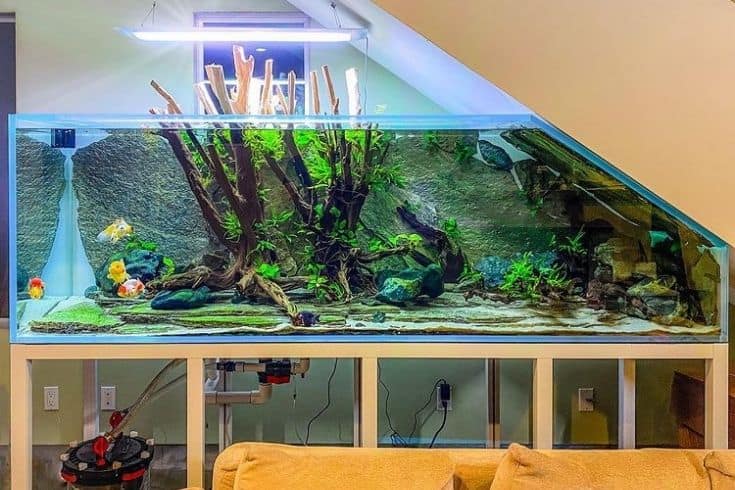
Choosing the right aeration system is vital, especially if your tank has shallow water levels. In general, we recommend using an air stone or an external filter to aerate your tank. These devices are relatively inexpensive, and will not take up much space in your aquarium.
Although bettas are labyrinth fish that breathe air from the water surface, they still benefit from having a well-oxygenated tank. An aeration system will help keep the water oxygenated and provide your fish with a more natural environment.
Plants and Decorations
Plants do a lot for the water column in your tank. They help keep the water clean and free of toxins and provide hiding places for your fish. If you choose to add plants to your tank, make sure they are non-toxic and safe for bettas. Some common betta-safe plants include java fern, hornwort, and anacharis.
Generally speaking, flat-leaved plants are the best choice for betta tanks. These plants have a large surface area, which can double as a resting spot for your crowntails. If you’ve ever spotted a betta fish resting on a betta hammock, you’ve seen how much they enjoy flat-leaved plants!
In addition to plants, you can also add other decorations to your tank. It’s best to steer clear of things with sharp edges, like rocks and coral, as these can injure your fish. Instead, opt for smooth decorations that won’t harm your betta if they happen to bump into them.
Common Health Issues
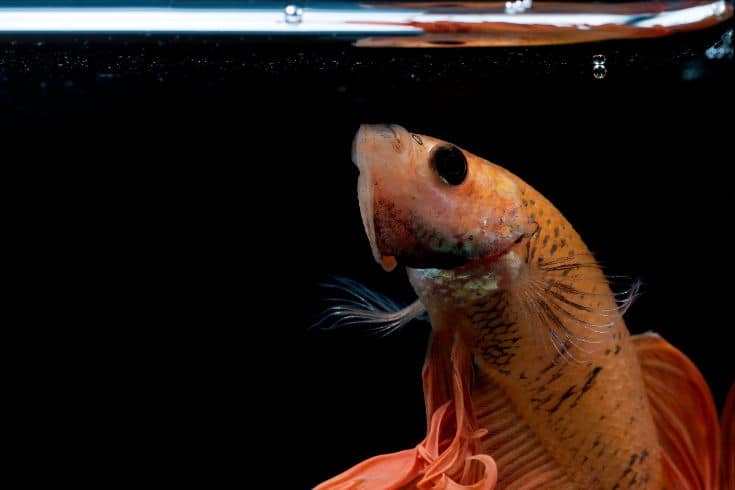
Now that you know the basics of crowntail betta care, it’s time to learn about some of the most common health issues these fish face. By understanding these issues, you can be better prepared to deal with them if they ever arise. Here are some of the most common health problems that crowntails face:
Bloating
Excessive bloating is a common issue in bettas and is often caused by overeating. If your crowntails’ belly looks bloated or distended, it’s important to take action immediately. Bloating can lead to a number of serious health problems, and can even be fatal if left untreated. Your fish’s swollen body will make it difficult for them to swim, and they may even have trouble breathing.
If you notice that your crowntail is bloated, you should first reduce the amount of food you’re giving them. In most cases, swelling is accompanied by a loss of appetite anyway, so your fish probably won’t be too hungry. You can also try fasting your fish for a day or two to help reduce the swelling.
In addition to reducing the amount of food you give your fish, you should also increase the frequency of water changes. This will help remove any toxins from the water that could make the bloating worse. You want to provide your fish with amazing care during this time, so don’t hesitate to make more water changes than usual.
White Spot Disease (Ich)
Ich is one of the most common diseases in aquarium fish, and bettas are no exception. This disease is caused by a parasite that infects the fish’s skin and can quickly spread to the gills and other organs. Symptoms of ich include white spots on the skin, flared fins, and increased respiratory rate. In severe cases, ich can be fatal.
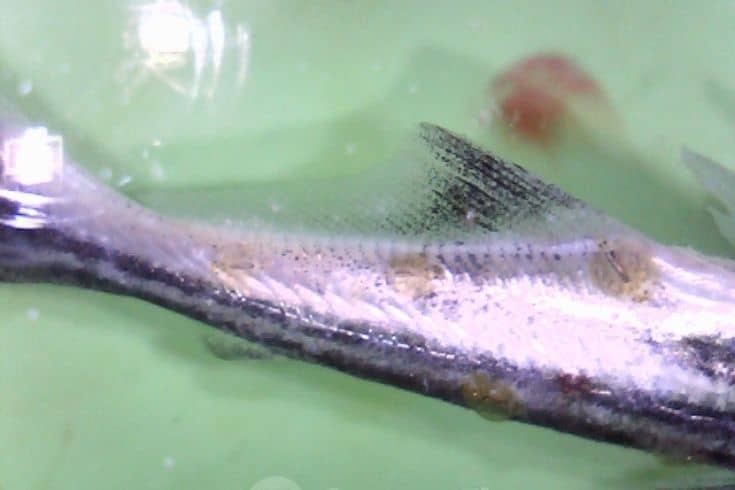
If you notice any of these symptoms in your crowntail, it’s important to take action immediately. The sooner you treat the disease, the better. There are a number of commercial treatments available for ich, and most pet stores will have at least one or two options.
Prevention is the most important thing when it comes to ich, and there are a few betta care reminders that can help you avoid this disease. First, quarantine any new fish before adding them to your tank. Then, keep your tank clean and free of debris. A dirty tank is the perfect breeding ground for ich, so keeping things clean is important.
Abrasions
Try as you might, there’s always a chance that your crowntail will suffer from an abrasion at some point. These wounds can be caused by anything from running into a rough surface to getting nipped by another fish. Abrasions usually aren’t serious, but they can become infected if they’re not treated properly.
Mild abrasions may not be immediately noticeable, but they will usually cause general signs of stress in your fish. These signs include subdued colors, lethargy, and a loss of appetite. If you notice any of these symptoms, it’s important to check your fish for wounds.
Breeding Your Crowntail Betta
Having a healthy, happy crowntail betta is one thing, but breeding them is a whole other story. These fish are a result of generations of selective breeding, so this is not a process that should be taken lightly. In fact, the domestic breeding of crowntail bettas is still relatively new, and a number of things need to be considered before taking the plunge.
First, you need to make sure that you have a separate tank with a large enough surface for nesting. Like all bettas, crowntails are bubble nesters. Males typically start forming bubble clusters at around 3 months of age, but this can vary depending on the individual fish. Once the male builds his nest, he will be ready to begin the mating ritual.
As part of the mating ritual, the male will perform a dance for the female. If she is impressed by his performance, she will lay her eggs. The male then retrieves them from the bottom of the tank and places them in the bubble nest. After three days, the fry will hatch and be able to swim on their own.
Crowntail Betta Fish Tank Requirements – Product Recommendations
Earlier, we touched upon the importance of a spacious tank in keeping your betta fish happy. We also talked about the importance of selecting compatible tropical fish if you intend to create a community tank for your bettas. Regardless of your setup, every tank should have a few key components. Here are our top product recommendations for a happy, healthy crowntail betta:
The right food: A high-quality betta food will help your fish stay healthy and vibrant. We recommend the Betta Buffet pellets from Tetra. Many fish owners observe brighter colors and more active fish after switching to this food.
A good light: Crowntails come in a variety of colors, and a good light will help show off their true beauty. We recommend the Fluval Plant 3.0 LED aquarium light. This light is designed specifically for plant growth, but it also does a great job of highlighting the colors of fish.
An aquarium filter: A good filter is essential for keeping your tank clean and your fish healthy. We recommend the Fluval AquaClear 50 Power Filter. This filter is quiet, efficient, and readily available in most fish stores.
The Takeaway: Do Crowntail Bettas Make Good Pets?
Crowntails are undoubtedly one of the most beautiful betta fish varieties. They come in a wide range of colors and patterns and are relatively easy to care for. We hope this guide has helped you learn everything you need to know about these amazing fish.
Do you have experience with crowntail bettas? We’d love to hear about it in the comments below! And if you know someone who’s thinking about getting a crowntail, be sure to share this article with them. Thanks for reading, and happy fishkeeping!
